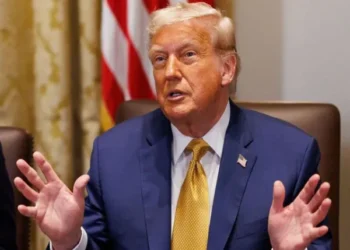Washington, D.C. — In a dramatic escalation of trade tensions, former U.S. President Donald Trump announced that a 35% import tax will be imposed on products imported from Canada, effective August 1, 2025. The declaration has sent shockwaves through international markets, bilateral trade circles, and diplomatic channels across North America.
The announcement was made via Trump’s official social media account late last night and quickly gained widespread attention in both U.S. and Canadian media. According to Trump, this move is part of a broader trade realignment strategy aimed at protecting American industries, revamping trade deals, and pushing foreign governments to the negotiating table under stricter U.S. terms.
📌 Trump’s Statement: 35% Tariff to Begin August 1
In his official post, Trump stated:
“Starting August 1, 2025, all products imported from Canada into the United States will be subject to a 35% tariff, regardless of sector. This is necessary to protect American workers and businesses. We must prioritize America first.”
This tariff will be separate from any sectoral or existing tariffs that already apply to Canadian imports. The new tax, according to Trump, will be universal and non-discriminatory, covering everything from raw materials to finished consumer goods.
🎙️ Further Clarification on NBC’s ‘Meet the Press’
Speaking to NBC’s Meet the Press host Kirsten Walker, President Trump elaborated on his broader tariff policy. He revealed that the tariff on Canada is just the beginning. Several other countries are also being warned of similar consequences if trade negotiations with the U.S. are not concluded swiftly and in favor of American interests.
“We’re just going to say it clearly now: all remaining countries that haven’t signed trade deals or received trade letters — we’ll impose taxes, maybe 20%, maybe 15%. We’ll work that out. But Canada? 35% from August 1.”
Trump’s comments signal a return to his ‘America First’ economic doctrine, reminiscent of the aggressive tariff policies he enforced during his previous presidency, particularly against China and the European Union.
🇺🇸🇨🇦 U.S.-Canada Trade: A Deep and Complex Economic Relationship
The imposition of a 35% tariff on Canadian imports marks a significant rupture in what has historically been one of the strongest trade relationships in the world. The United States and Canada share over $1.3 trillion in bilateral trade annually, with thousands of jobs on both sides of the border dependent on cross-border commerce.
Key sectors impacted by the tariffs include:
- Automotive parts and vehicles
- Agricultural products (wheat, canola, beef, dairy)
- Lumber and building materials
- Aluminum and steel
- Energy (crude oil, natural gas, hydroelectricity)
If enforced, the new tariff is expected to result in higher costs for American consumers, potential retaliatory tariffs by Canada, and supply chain disruptions for industries that heavily rely on Canadian goods.
📦 What the Tariff Means for American Businesses and Consumers
The 35% import duty on Canadian goods would represent a massive cost increase for American companies that rely on Canadian materials or products.
For instance:
- Automotive manufacturers sourcing parts from Ontario may face price hikes.
- Construction companies may see soaring prices for lumber and cement.
- Supermarkets may be hit with higher food prices, especially in border states.
Economists warn that the tariffs could fuel inflation, particularly in sectors already struggling with post-pandemic supply chain disruptions and rising global commodity prices.
“This could trigger a fresh round of price increases across the board,” said Dr. Emily Jenkins, a trade economist at Georgetown University. “Ultimately, the burden falls on consumers.”
⚖️ International Reactions: Canada Expected to Retaliate
Canadian officials have yet to issue an official response, but trade analysts expect a strong reaction from Ottawa, possibly including counter-tariffs, WTO complaints, and appeals to multilateral trade mechanisms.
In previous tariff disputes under Trump’s administration, such as the 2018 steel and aluminum tariffs, Canada responded with reciprocal measures, targeting U.S. exports including orange juice, whiskey, and motorcycles.
“This type of unilateral action undermines decades of partnership and mutual prosperity. We will defend Canadian workers and industries,” a senior Canadian diplomat told reporters under anonymity.
📜 Letters Sent to 20+ Countries: Global Trade Implications
According to sources cited by an American news channel, President Trump has sent formal notices to more than 20 countries warning them that if no trade agreement is signed by August 1, they too will face tariffs on all imports to the U.S.
Countries allegedly included in the warning list are:
- Mexico
- Germany
- Japan
- South Korea
- Vietnam
- Brazil
The new policy would mark a dramatic shift toward protectionism in U.S. trade policy, echoing moves from Trump’s first term that triggered global trade tensions, including tariff wars with China and European countries.
💬 Criticism from U.S. Business and Trade Groups
Unsurprisingly, American business lobbies have expressed concern over the unilateral imposition of tariffs without Congressional consultation or economic impact assessment.
The U.S. Chamber of Commerce, in a brief statement, said:
“While we support fair trade, blanket tariffs risk harming American businesses, consumers, and long-standing alliances.”
Similarly, the National Retail Federation warned that such tariffs could reduce inventory availability, cause job losses, and result in legal challenges at the World Trade Organization (WTO).
🗳️ A Political Strategy Ahead of Elections?
Many analysts believe Trump’s move may also be strategic in the lead-up to the 2026 midterm elections. His America First trade policy was central to his political platform in 2016 and 2020, winning favor among working-class voters in key industrial states like Michigan, Pennsylvania, and Ohio.
“Tariffs play well with a certain base,” explained political strategist Jason McNeil. “It sends a message of strength, sovereignty, and economic nationalism.”
However, critics argue that the economic fallout could alienate moderates and small business owners, especially if inflation spikes again.
🧾 A Look Back: Trump’s Previous Tariff Wars
Trump’s first term saw the U.S. engage in significant trade wars, particularly with China, where tariffs were applied to over $360 billion worth of goods. Despite initial promises that tariffs would boost U.S. manufacturing, results were mixed:
- Higher consumer prices
- Retaliatory tariffs from trade partners
- Disruptions in agricultural exports
Many farmers and industrial firms received federal bailouts to cushion the blow. A repeat of that situation could become politically and economically costly.
🧠 Conclusion: A New Trade Era or Repeat of the Past?
President Donald Trump’s imposition of a 35% import tax on Canada signals a bold, confrontational phase in U.S. trade policy. Whether it leads to fairer trade agreements or escalates into a global trade war, only time will tell.
For now, businesses, consumers, and governments around the world must prepare for potential economic volatility, supply chain restructuring, and diplomatic tensions.

























